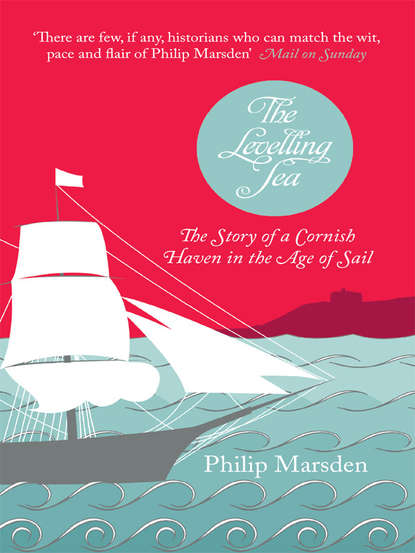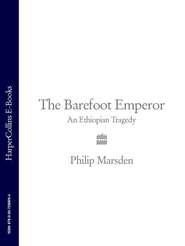По всем вопросам обращайтесь на: info@litportal.ru
(©) 2003-2024.
✖
The Levelling Sea: The Story of a Cornish Haven in the Age of Sail
Настройки чтения
Размер шрифта
Высота строк
Поля
One day a few weeks later, I row out to Liberty, fold up the cover and pump the bilges. The summer yachts have thinned out, laid up in the sheltered corners of the creeks. The shoreside oaks are still green, but something tired now shows in their foliage. A few hundred yards to the south, the Victorian facade of Place Manor rises from its sweep of lawn and gravelled drive. Almost completely hidden behind it is the much older church of St Anthony’s, its tower just clearing the manor’s roof like the mast of a sunken ship.
I drop the mooring and head out towards St Mawes Castle. From the far headland rises Pendennis Castle, and the two stand guard over the estuary’s approaches. When the religious community around St Anthony’s church was dissolved during the Reformation, the buildings were pulled down and the stone barged across the harbour to build St Mawes Castle. With a neat circularity, the castle had been commissioned to oppose the threat of papal retribution that followed the Reformation and the Dissolution.
In Falmouth, I moor up at the pontoon and walk through the town, over the railway, through a just-ploughed field to the hilltop church of St Budock. According to the boast on the service board, the church was founded in AD 473–1,000 years before the first buildings of Falmouth appeared above the strand. Budoc himself was one of the greatest of the sea-soaked saints of the Celtic Church. Venerated in Ireland, Wales and Cornwall, his story was carried between them, embellished by a thousand tellings. On Brittany’s hazardous shoreline, he has been called ‘le patron de ces côtes’ and in the miracles of his life, you can sense the particular licence of maritime myth: an adventure from the start, beginning in the middle of the English Channel, where Budoc was born in a bobbing barrel. Shaped by the winds, his earthly mission left him here for several years, above the Fal estuary, with his small group of monks, before he again took to the Channel, floating to Brittany in a stone coffin.
The church interior is damp and dark. Morning light falls through the high altar window, flashing on and off as clouds slide across the sun. A harvest tableau stands in a niche – bread rolls and a vase of poppies and cornflowers. Kneeling in front of the altar rail, I take the edge of the runner and roll it back beneath the chancel, revealing a grid of terracotta tiles. In the centre, set into stone, glints the panel I am looking for:
HERE LYETH IOHN KILLIGREW ESQVIER, OF ARWENACK …
AND ELIZABETH TREWINNARD HIS WIFE … GOD TOOK
HIM TO HIS MERCY THE YEARE OF OUR LORD 1567 …
Above the inscription, mottled with age, lie the couple’s brass images. I bend to examine them more closely. No trace of human softness crosses their faces, none of the flamboyance of the later Elizabethans. They are standing in prayer. Framed by a wimple, Elizabeth Killigrew’s expression is stern and manly. John Killigrew’s hair and beard are cropped short and he is dressed in armour – vambrace and breastplate, and sword trailing to the ground.
Yet these two can rightly be called the grandparents of the port of Falmouth. With their ten children, they produced a dynasty that spread far beyond Cornwall, a line of mariners and politicians, pirates and felons, diplomats and courtiers who played a part in succesive royal courts, while here in their patch of shoreside territory, they carved a fief from open fields and cliffs, and from a minor estate a port connected to the furthest points of the known world.
John and Elizabeth Killigrew.
The family was not originally from the coast. The small farm of Killigrew – meaning ‘nut-grove’ (not ‘grove of eagles’ as is often supposed) – was located to the north of Truro, half a day’s ride from the open sea. (Long after the Killigrews had gone from the town at Falmouth, the yard at Killigrew could still be seen. Not until the late 1990s was it finally destroyed, when teams of yellow earth-movers and diggers parked in it while they reshaped the land for the Trispen bypass.) It was through marriage, at about the turn of the fourteenth century, that the Killigrews became associated with the manor of Arwenack. From then on their name crops up in the records of Glasney College – as does that of John’s wife, Trewinnard. But while Penryn and Glasney prospered, safe behind their chain-barrage, Arwenack remained of little importance.
For years, the Killigrews lived the provincial life of Cornwall’s gentry, those families who owned land around the county, who married each other and visited each other in an atmosphere of leisure and conviviality. ‘A gentlemen and his wife,’ wrote Richard Carew, ‘will ride to make merry with his next neighbour, and after a day or twain those two couples go to a third, in which progress they increase like snowballs.’
With the breaking-up of the church estates and the building of the two castles at St Mawes and Pendennis, power shifted on the shores of the Fal. Like a crab with a new shell, John Killigrew crept out from under his rock and snapped up much of Glasney’s land. Soon he controlled the tithes of sixteen parishes. By buying up the south bank of the Helford, he controlled most of that river too. The land for Pendennis Castle was leased from him. Two of his sons received lucrative commissions for overseeing its building. When the castle was complete, John became its first captain and remained so for the rest of his life.
Pendennis Castle made a little king of John Killigrew, protecting Arwenack from marauding ships and fortifying his status with Crown bombards and perriers, pyramids of stone shot and keep-walls 11 feet thick. He joined that class of Tudor men who grew suddenly wealthy from the easy pickings of church land. Killigrew was particularly fortunate: not only did he have an enlarged estate and a brand-new castle, he also had the sea. The combination gave him control of one of the best anchorages in the land, and a power that was constrained by little more than the laws of wind and tide.
When Queen Mary came to the throne in 1554, and began to reverse the heretical advances of the Protestants, John Killigrew at once involved himself in the insurrection against her. Having no real authority as far west as the Fal, the new queen was forced to try to win him over. She reappointed him to his post at Pendennis. Her Privy Council confirmed his command of the castle, which he must ‘diligently, faithfullie and truly kepe, save and defende with all his power, connyng and industrie’. He and his sons did nothing diligently, faithfully or truly. They continued to plot against the Queen. Two were implicated with Sir Peter Carew in Wyatt’s rebellion. They fled to France where Henry II was happy to provide them with ships to attack the Spanish vessels of Mary’s husband, Philip II. Along with a number of other families from the Cornish and Devon coasts, the Killigrews conducted an ongoing campaign against Philip’s shipping in the Channel. Their small-time piracy, the habit of centuries among seafarers of Channel shores, became more political. The maritime historian Kenneth Andrews identifies a shift in motive at about this time: ‘the gentry took the lead, especially the west country families connected with the sea, for whom Protestantism, patriotism and plunder became virtually synonymous … the Cornish Tremaynes and Killigrews embarked on an unofficial war with Spain.’
Back and forth across the Channel the Killigrews sailed – harrying the Spanish and taking Protestant rebels into exile in France. During the hot summer of 1556 – heat which drove the frail queen to her bed – Mary’s Privy Council lost patience with the pirates. At Arwenack, John Killigrew was arrested and with his heir, also John, brought up to London. The two were thrown into the Fleet Prison. At the same time, in the Queen’s name, a small squadron was sent into the Channel to round up rebel ships. The force was commanded by the veteran pirate-hunter, Sir William Tyrell.
Tyrell had immediate success. Soon, just above the low-water mark at Wapping Stairs, six pirates swung from gibbets. He went to sea again and, according to the Acts of the Privy Council, captured ‘ten English pirate vessels’. One of the commanders escaped to Ireland in a small boat, where he was killed by local men as he struggled ashore. Another – who had escaped Tyrell for years – was Peter Killigrew.
Of all the five sons of Arwenack Manor, Peter was the best-known sea-rover. The Venetian ambassador in London described him as ‘an old pirate, whose name and exploits are most notorious, and he is therefore in great repute and favour with the French’. At first, Peter Killigrew escaped again, was recaptured, tried to stuff 150 crowns into the skirts ‘of his woman’ and was finally taken in chains to London. Twenty-four of the ordinary seamen were hanged at Southampton, and another seven at Wapping.
Peter was not killed at once. He and his brother were taken to the Tower where they later alleged they were tortured. From their confession comes a tale that resonates down the ages with an authenticity more convincing than the J. M. Barrie, dyed-in-the-wool brigand. Peter Killigrew was weary. He had known too many night chases, too many hostile landfalls, too many deceptions and betrayals. All he wished to do, he now explained, like any self-respecting mariner of the times, was to sail to the gold mines of Guinea and return with enough to retire on. He would then, he claimed, buy a house in Italy and never again put to sea.
By this time, his father had been released from the Fleet, and promised to pay compensation to anyone wronged by his miscreant sons. With their marine skills and position, the Killigrews were deemed ‘useful’. Peter Killigrew was put in charge of the Jerfalcon, part of a naval squadron active in the war against France. John and his eldest son returned to Cornwall. Within a year Elizabeth was queen and John Killigrew’s Protestant fiefdom, centred on Arwenack and Pendennis Castle, was once more in sympathy with the Crown. Pugnacious seamen like the Killigrews were no longer outlaws but set to become the very drivers of the new regime.
During the later years of his life, John Killigrew amassed a sizeable fortune. As governor of Pendennis, he continued to use the waters of the lower Fal to his advantage, in line with many of Elizabethan England’s most colourful ventures, seizing chances as they came, exploiting the legal ambiguity and anonymity of the sea. Even so, his maverick methods infuriated the state. Throughout the mid-1560s they received reports of his piracy and ‘evill usage in keeping of a castell’.
John’s son Peter may genuinely have intended to retire, to reach Guinea, and buy a house in Italy. But it was easier to carry on doing what he did best, using the Killigrew lands on the Helford river as a base for his dubious trading. Helford – nicknamed Stealford – became known as a safe haven for pirates, a place to offload and distribute plunder without risk. The Killigrews operated their own mini-state around Falmouth. When an envoy of the Privy Council was sent to Arwenack to claim 184 rubies stolen by Peter, John Killigrew – then in his seventies – reached for his sword and threatened to stick him.
With sea-gained bounty, the elderly John Killigrew set about rebuilding Arwenack Manor. Carts brought granite from Mabe quarry and, for ornament, barges of free stone from along the coast at Pentewan. Gables and high chimneys multiplied out from a three-storey central tower. A line of battlements ran along the top of the banqueting hall. A courtyard was enclosed on three sides, while on the fourth it opened onto a water-gate with a short canal dug out from the marshy ground of Bar Pool. John Killigrew’s expansion of Arwenack, according to the family’s chronicler, made it ‘the finest and most costly house in Cornwall’. The bill rose towards £6,000. But just as the last fittings were put in place, in November 1567, John Killigrew died.
The sun flashes again on his brass likeness. Half-armoured, he looks every inch the late-Tudor strongman, his stance and expression set hard against the centuries between us. Opportunistic, fiercely Protestant, equating any sense of authority with the priestly rule of the past, he found in the sea an arena in which to exercise his will with impunity, a new breed of man, a semi-licensed rogue as yet untamed, clanking out of the Middle Ages to help lay the foundations of modern Britain.
CHAPTER 4
From the decades following John Killigrew’s death comes one of the earliest and most striking images of Falmouth. Buried deep in the British Library, under ‘highly restricted’ access, the picture is bound into a volume of Christopher Saxton’s maps of England’s counties – known as the first English atlas. The volume was collated by Queen Elizabeth’s secretary of state Lord Burghley during the 1570s – a period which happened also to see the most explosive progress in the history of English seafaring.
In the hush of the Manuscripts Room, I rest Burghley’s volume on a foam cradle. I raise its pasteboard cover. The pages turn with a stiff and biblical crinkling. Saxton’s Atlas reveals an England of crimson villages, rivers of heavenly blue, well-spaced market towns, lime-coloured hills and a jagged coastline back-shaded with gold. Its pretty pages, each showing its bordered shire, speak of the merits of regional order, and echo Burghley’s own tireless efforts to achieve it.
Gathered in among them, Folio 9 is of a wholly different character, less stylised and much more exuberant. An inlay of vellum in a paper frame, the folio has on its reverse the title ‘Map of Falmouth Haven’. The words are written in a curator’s pencil, lightly marking the paper, like a whisper.
I turn the page and stand back. ‘Map’ is not right. Folio 9 is a painting, a wonderful vista of greens and yellows and browns, without symbol or key, without abstraction, with none of the functionality of Saxton’s counties. A half-inch rim of black ink runs around the map’s edge, sharpening its earthy tones. The image itself is a bird’s-eye view of the familiar shoreline of the lower Fal – the view of a lark somewhere high above Feock. It is early summer. The hedges are full. Woods and copses are thick with new growth, mounds of fresh-cut hay dry in the fields. You can sense the air’s fly-buzz and gorse-scent, follow the winding lanes, and feel beneath your feet the soft-grass ridge between the cart-furrows. But the image is really about the water: from almost every slope stretch the tidal tributaries and the pale-blue estuary of the Carrick Roads.
One of the first things you notice about the Burghley Map of Falmouth Haven is that it is upside down. The traditional south–north orientation is reversed. It does not, as you expect, start out at sea and guide you up from the Lizard towards the sheltering channel of the Fal. Folio 9 brings you in from the north, from the land, leads the gaze up and outwards into open space. Falmouth is no longer merely a bolt-hole for ships, or a handy aperture for the kingdom’s enemies. It is here presented as a conduit to the empty horizon. The overall effect is an urging, a siren cry: leave behind the old terrestrial certainties! Join in the great sea-based bonanza!
Detail from the Burghley Map of Falmouth Haven.
A glow of patriotism radiates from the manuscript. The castles appear jaunty and solid. Over the lower blockhouse of Pendennis rises a St George flag so large that it looks set to topple the little tower. From the castle itself flutters a Royal Standard of impossible size – peer closely and you can see the gilded symbols flashing like tiny jewels: six rampant passant lions, one rampant, and the curves of the Irish harp.
By contrast, the ancient town of Penryn, with its outdated, pre-Reformation dominance, is shunted to the bottom of the map. The cross-river chain is shown, and below it the remains of Glasney College. Years earlier, before the Norman Conquest, Penryn had been one of Cornwall’s largest population centres, second only to the county town, Launceston. Here it is almost ignored, pressed to the margins, where four centuries of thumb-grasps and page-turnings have flaked the paint so that the town now looks to be in the midst of a snowstorm.
Where Falmouth will emerge during the coming century there is just shale and shingle in the very slight recess of Smithwick Creek, and on the cliff above, open ground. Only one building is drawn, a low shed marked lym-kiln. The great port has its lowly origins here: on an empty beach, in the swampy ground above, and in the cob-walls of a small lime-kiln.
Dominating the picture, dwarfing the ancient town of Penryn, is Arwenack Manor, the most opulent and expensive house in Cornwall. Placed between Pendennis Castle above and Penryn below, the house appears in style to be the child of both. With its battlements and towers, it has taken on the martial character of Pendennis. But in the courtyards, the mullioned windows and the long facade, the vast manor carries an ironic resemblance to Glasney College whose destruction allowed the Killigrews to create it. Aglow with Protestant triumphalism, surrounded by its neatly fenced demesne land, it fills the map with its worldly fortitude.
Such is the precedence given to Arwenack that the whole image suggests a piece of propaganda for the Killigrew family. It is usually assumed that Burghley himself commissioned the map, yet although he bound other manuscript maps into Saxton’s Atlas, Falmouth is the only large-scale depiction of a harbour. Whether he asked for it or whether it was presented to him unsolicited is not clear.
The Killigrew family and Lord Burghley were certainly known to each other. Burghley would have been aware of old John, Pendennis’s first governor, his sudden rise, his imprisonment, his pirate son Peter and all the nefarious sea-tales of the family. But he also knew more directly, from court, two of the sons who were rather better behaved. William Killigrew was an MP, who in his career represented Cornish constituencies in a total of seven Parliaments (no Cornish family of the time provided more MPs than the Killigrews). William was also Groom to Elizabeth I’s Bed Chamber. His brother Henry Killigrew was even closer to the Queen’s inner circle, by turns Teller of the Exchequer and Surveyor of the Armoury, and her chosen envoy on a number of vital missions to Scotland, France and the Netherlands. But the closest link was that Henry Killigrew and Lord Burghley were married to sisters, the famous daughters of Sir Anthony Cooke (a third was married to Sir Nicholas Bacon).
An upbringing in the rowdy atmosphere of Arwenack, with its visiting ships, its Huguenot rovers and Dutch sea-beggars, had prepared Henry Killigrew for an adventurous political career. He spent Mary’s reign in exile and perfected his French and Italian. He was not a tall man and acquired a permanent limp from a wound picked up in the siege of Rouen in 1562. When he was released, and Rouen relieved, it seemed Elizabeth and England were in the ascendant. Henry Killigrew wrote to his wife’s brother-in-law, Lord Burghley (then William Cecil): ‘God prosper you as He has begun, and inspire her Majesty to build up the temple of Jerusalem.’
Burghley has annotated each of his county maps with a list of its ‘justices’. There is a sense of him trying to order the kingdom, to catalogue it for better governance – or any governance. In Mortlake, the mystic John Dee was building a mythical Jerusalem for his queen, while Burghley, the great administrator, was assembling the more solid building-blocks for a civil state.
But Lord Burghley and the Killigrews of Arwenack were also at odds. In their respective attitudes to the sea, each represents a distinct thread of English interests which, when wound together, stretched taut through the coming centuries. One was legitimate, using the sea for the collective good; the other was illegal, exploiting it for private gain. One produced the Royal Navy, the other spun off into piracy. Each developed seamanship and a certain arrogance at sea, contributing in its own way to the victories of Drake, Cochrane and Nelson.
Burghley was among those who understood that the country’s future – indeed its survival – lay in naval strength. He took personal control of the political aspects of the Royal Navy, and spent the 1560s and 1570s building up capacity, commissioning surveys of shipping and mobilising. He had a great love of geography and his copy of Saxton’s Atlas also includes a map of the coast of Norway, Sweden and northern Russia. He was famous for his meticulous knowledge of the places of Europe. Yet he himself left British shores only once in his life, for a brief visit to the Low Countries.
The rise in piracy, represented by the Cornish Killigews, angered him; fish were the rightful yield of the seas, not plunder. Those who lived by the coast should spread nets to feed the people, not sail off on prize-grabbing adventures. But since the Reformation, and the relaxation of fast days, demand for fish had shrunk: to eat meat on a Friday, to roll your jaws over bloody slabs of beef, became an affirmation of Protestant faith, and it left fishermen with a shrinking market. They stowed their nets and joined privateers. To try to induce them back, Burghley – still William Cecil at the time – introduced a government bill to make twice-weekly fish-eating compulsory. His measure was jeered in the House for its Popish implications, and dubbed ‘Cecil’s Fast’.
The Killigrews on the other hand saw the sea as a source of personal gain. Arwenack became a hub for the illicit side of seaborne enterprise, for privateering, a practice which took off during the last decades of Tudor rule. Elizabethan ‘privateering’ was, strictly, distinct from the seventeenth-and eighteenth-century practice which spawned the term, but it offered the same dubious licence to attack foreign ships as redress for lost cargoes. In the sixteenth century, this licence was provided through a ‘letter of marque’. If a merchant or captain was robbed of his goods by a foreign power, he was given a chit which allowed him to snatch compensation in kind from any ships of that power. Often the letters themselves were exchanged for money, and often not held at all. In practice, privateering was little more than semi-sanctioned piracy.
To Burghley, it made a mockery of the rule of law, and jeopardised relations with other nations, particularly Spain. But with hindsight, the spirit of privateering characterises the Elizabethan age – the ship as the vessel of the wildest hopes, the heady myth-making, the heroic sea voyages, the failure of the Spanish Armadas. Privateering also had one great practical benefit: it proved the nation’s greatest school for maritime skills.
The countless and nameless figures who manned the privateers learned the advantages of the modern rig with its auxiliary sails. They learned to use the mesh of halyards and lifts and sheets. They learned how to charge the guns with volatile serpentine powder, and how to damp the recoil. And they learned something far more important, that despite the risks and discomforts, a successful foray into the Channel, or the taking of a Spanish prize, could bring greater reward than a lifetime of toil. The sea and quick wealth become part of a powerful association for coastal communities, brought together in the arts of seamanship.
Life on board a privateer was brutal and anarchic, lacking either the hierarchical order of Spanish ships or the fierce discipline of the later Royal Navy. Privateers were mutual enterprises, operated on the same basis as fishing boats, with the crew receiving no wages but reaping a third of the takings. They would coerce the captain if they disagreed with him – ‘shite on thy commissions!’ – or simply mutiny. There were open fights. The ships were often shockingly overmanned and under-victualled. Scurvy and the flux laid whole companies low; there were instances of starvation. But when a prize was sighted, all disputes were forgotten. The men took to their stations, gaining the weather-gage, firing on the prize not to sink it but to disable it. With small arms – fowlers and murderers, muskets and calivers – the ship was boarded. If booty was not revealed by searching, it was discovered by persuasion – wrapping ropes around the head, or bowstrings around the genitals.
As well as rewarding those with sea-skills, such enterprise encouraged private investment in ships. By the end of the century, the English merchant fleet outnumbered the Queen’s own by twenty to one. The ships landed up to £200,000 a year in illicit prize money, establishing new fortunes, no longer tied up in land, as liquid as the sea that yielded them, a fund of robber capital that grew and grew, doubling by the decade, funding more ships and more ventures, and swelling through the seventeenth and eighteenth centuries into the prosperity on which Britain’s global power was based.
On the Burghley Map, ships fill the blank sea-spaces with gleeful profusion. To the west of Pendennis an English three-master fires, rather gratuitously, on a caravel (its southern shape suggesting devious papist intentions). Another three-master waits to the south of Pendennis. In the Carrick Roads, marked by a couple of paddock-size St George’s ensigns, a powerful squadron lies at anchor. But there are other ships, too, which fly no official flags. Mylor has a couple, St Mawes a couple more (Penryn has none); three more lie off St Methick’s Point. But the greatest number, arranged in neat formation, lie off Killigrew land, a cluster of eight off Arwenack Manor.
Burghley’s own handwriting has been identified on his map of Falmouth Haven and it is easy to imagine him during the dangerous years of the late sixteenth century, surveying his atlas and pausing to scrutinise Folio 9. He would have ignored the Killigrews’ display of standard-waving from Pendennis Castle, seeing it for the sham it was, likewise the bellicose men-of-war. But he would have noticed, too, that anonymous group off Arwenack, their pack-like poise and confidence, and been reminded of the renegade threat of privateering.
Their rig is identical. Three masts, two bare yards on the fore and main, and a spar aft on the mizzen. A bumpkin juts from a high transom stern. The images are too small to see what guns they carry – typically a clutch of sakers, minions and falconets. They are not big, perhaps fifty or sixty tons burden, easily affordable for a private syndicate – but in the history of ship design they represented the most efficient vessels that had ever sailed.









